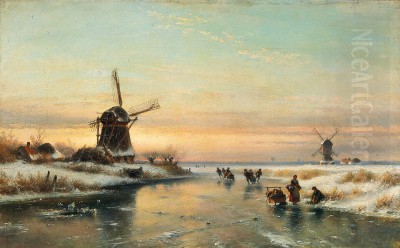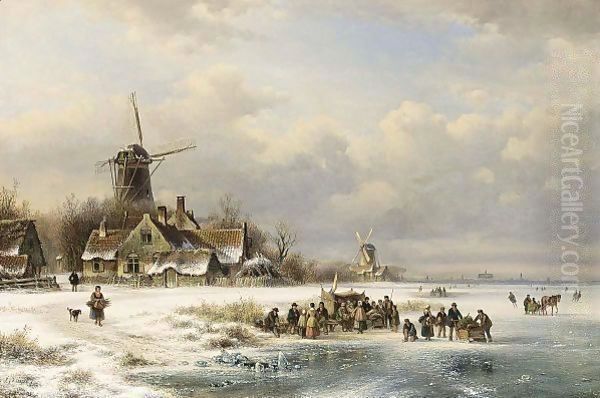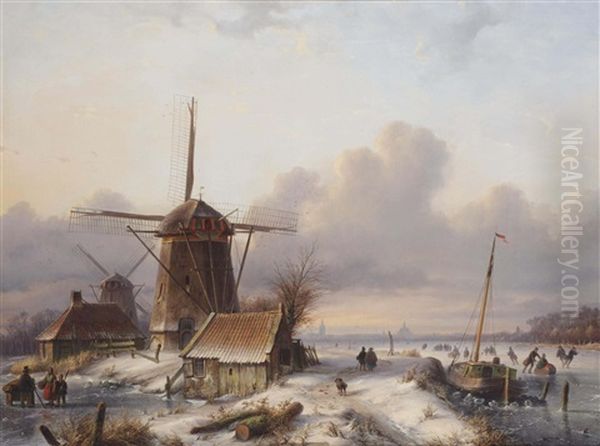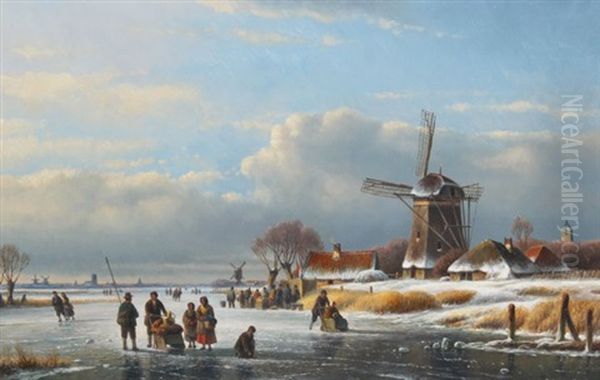
Lodewijk Johannes Kleijn stands as a significant figure within the rich tapestry of 19th-century Dutch art. Born in Loosduinen, near The Hague, in 1817, and passing away in The Hague in 1897, Kleijn dedicated his artistic life to capturing the landscapes and daily life of his homeland. He emerged as a prominent painter during the era of Dutch Romanticism, a period where artists sought to blend detailed observation with an idealized, often nostalgic, vision of the Netherlands.
Kleijn is particularly celebrated for his evocative depictions of winter scenes. His canvases frequently come alive with the cheerful bustle of skaters gliding across frozen canals and rivers, sleighs making their way through snowy villages, and the characteristic Dutch windmills standing sentinel against crisp winter skies. These works not only showcase his technical skill but also tap into a deep cultural appreciation for the unique beauty and social activities associated with winter in the Netherlands. His contribution lies in his ability to render these familiar scenes with both precision and atmospheric charm.
Early Life and Artistic Awakening
The Netherlands into which Lodewijk Johannes Kleijn was born was a nation rediscovering its artistic heritage while forging a new identity in the post-Napoleonic era. The 17th-century Golden Age of Dutch painting, with masters like Jacob van Ruisdael and Jan van Goyen who had excelled in landscape, cast a long shadow, providing both inspiration and a benchmark for later generations. The early 19th century saw a resurgence of interest in landscape painting, viewed through the lens of Romantic sensibility.
Growing up near The Hague, a major artistic and administrative centre, Kleijn would have been exposed to this environment. While specific details about his earliest artistic inclinations are scarce, it's clear he gravitated towards landscape painting. The Dutch landscape, with its flat expanses, intricate waterways, and dramatic skies, offered fertile ground for artists seeking to capture the national spirit. Early Romantic painters like Wouter Johannes van Troostwijk had already begun exploring atmospheric effects and more intimate views of nature, paving the way for the generation Kleijn belonged to.
The Guiding Hand of Andreas Schelfhout

A pivotal figure in Kleijn's development was Andreas Schelfhout (1787-1870). Schelfhout was arguably the most influential Dutch landscape painter of the Romantic period, renowned particularly for his winter landscapes, which were immensely popular. His studio in The Hague became a magnet for aspiring artists eager to learn his meticulous technique and commercially successful formulas. While some sources suggest Kleijn might not have been a formal, long-term pupil in the strictest sense, his work undeniably bears the strong imprint of Schelfhout's style and thematic preferences.
Schelfhout's influence is evident in Kleijn's careful compositions, his attention to detail, and his skillful rendering of ice, snow, and the specific quality of winter light. Schelfhout perfected a type of picturesque winter scene, often populated with lively figures skating, sledding, or gathering around "koek-en-zopie" stalls (makeshift stands selling cakes and warm drinks on the ice), and Kleijn adeptly adopted and adapted this popular genre. Kleijn learned to balance detailed realism with an overall harmonious and often idealized atmosphere, a hallmark of Schelfhout's teaching.
Schelfhout's studio nurtured several talents who became notable artists in their own right. Among Kleijn's contemporaries who felt Schelfhout's influence were Charles Leickert, another specialist in winter scenes and cityscapes, and Nicolaas Johannes Roosenboom, Schelfhout's son-in-law, who also painted landscapes in a similar vein. The tragically short-lived but brilliant Wijnand Nuijen was also associated with Schelfhout early on, pushing Romanticism towards more dramatic expression before his untimely death. Even Johan Barthold Jongkind, who would later become a crucial forerunner of Impressionism, spent time in Schelfhout's circle early in his career.
Embracing Dutch Romanticism
Lodewijk Johannes Kleijn operated firmly within the Dutch Romantic movement. Unlike the more turbulent or sublime focus found in German or British Romanticism, Dutch Romanticism often expressed itself through a more intimate and detailed appreciation of the national landscape and traditional life. It was less about overwhelming nature and more about the harmonious coexistence of humanity and the environment, often imbued with a sense of national pride and nostalgia, particularly looking back to the perceived tranquility and prosperity of the Golden Age.
Kleijn's work exemplifies these characteristics. His landscapes, whether winter or summer scenes, typically present an orderly, picturesque view of the Netherlands. The details are rendered with care, inviting the viewer to appreciate the textures of brickwork, the rigging of boats, or the specific activities of the figures depicted. Yet, this realism is often softened by an idealized light and a carefully balanced composition, creating a sense of peace and timelessness. His paintings offered comforting, recognizable visions of Dutch identity during a period of national consolidation.

His focus on typically Dutch motifs – windmills, canals, drawbridges, skaters, traditional boats – reinforced this connection to national identity. He wasn't seeking to revolutionize painting but rather to perfect a particular vision of his homeland that resonated deeply with the tastes of the time. His art provided an escape into a charming, well-ordered world, celebrating the enduring beauty of the Dutch landscape and the simple pleasures of life within it.
The Quintessential Winter Scene
It is for his winter landscapes that Lodewijk Johannes Kleijn remains best known. The Dutch have a long-standing cultural connection to winter and ice. Historically, frozen waterways became vital transportation routes and social gathering places. Skating emerged not just as a pastime but as a quintessential Dutch activity, depicted by artists as far back as the 17th century (e.g., Hendrick Avercamp). Kleijn tapped into this rich tradition, updating it for the 19th-century audience.
His winter scenes are rarely bleak or desolate. Instead, they often depict a community enjoying the opportunities afforded by the ice. Canals and rivers transform into bustling arenas for skaters of all ages. We see figures elegantly gliding, children playing, couples conversing, and vendors tending their koek-en-zopie stalls. These details provide narrative interest and social commentary, capturing a specific aspect of Dutch winter culture. The inclusion of these stalls, selling refreshments to those braving the cold, adds a layer of charming realism and social history to his works.
Kleijn masterfully captured the unique atmosphere of a cold, clear winter day. He paid close attention to the quality of light – the low sun casting long, blue shadows across the snow and ice, the reflections on the frozen surface, the crispness in the air. His snow is convincing, whether freshly fallen and blanketing rooftops or packed down on pathways. The bare branches of trees are delicately rendered against often luminous skies. Works like Skaters on a Frozen River or Winter Scene with Skaters encapsulate this specialty, offering idyllic yet believable glimpses into 19th-century Dutch life.
A Keen Eye for Detail and Light
A defining characteristic of Kleijn's art is his meticulous attention to detail. This aligns him with a long tradition in Dutch art, reminiscent of the 'fijnschilders' (fine painters) of the Golden Age, such as Gerrit Dou, although Kleijn applied this precision to landscape rather than genre interiors. He carefully rendered the textures of different materials – the rough wood of a boat, the smooth surface of ice, the intricate brickwork of buildings, the varied fabrics of clothing worn by the figures.

This detailed approach extended to the figures themselves. Though often small in scale within the larger landscape, they are usually depicted with enough specificity to convey their actions and social types. This careful rendering prevents the figures from becoming mere staffage; they actively contribute to the scene's narrative and atmosphere. Whether fishermen by a summer canal or townsfolk skating, their presence animates the landscape and provides a human connection.
Complementing his detailed brushwork was Kleijn's skillful manipulation of light and atmosphere. He understood how light defines form and creates mood. In his winter scenes, the cool, clear light enhances the sense of crispness and stillness. In his summer landscapes, a warmer, softer light often prevails, evoking tranquility and warmth. He employed atmospheric perspective effectively, with distant elements subtly fading in colour and detail to create a convincing sense of depth in the flat Dutch terrain. Reflections in water, whether liquid or frozen, were another area where he demonstrated considerable skill.
Venturing into Summer and City Views
While renowned for winter scenes, Kleijn's oeuvre was not limited to snow and ice. He also produced numerous summer landscapes, often depicting river or canal scenes under warmer skies. These works share the same qualities of careful composition, detailed execution, and tranquil atmosphere found in his winter paintings. Windmills, boats, cattle grazing in meadows, and figures engaged in leisurely pursuits like fishing are common motifs. Titles like Figures Fishing by a Water's Edge suggest this aspect of his work.
These summer scenes often showcase his ability to render foliage, calm water, and the hazy light of a Dutch summer day. They present an equally idealized, peaceful vision of rural life, complementing the cheerful activity of his winter pictures. The recurring presence of water remains central, highlighting the Netherlands' defining relationship with its canals, rivers, and lakes throughout the seasons.
Kleijn also painted cityscapes and coastal scenes. Views incorporating identifiable towns, perhaps The Hague or nearby Delft (as suggested by a title like Skaters by a River, Delft), demonstrate his ability to handle architectural elements within a landscape setting. His coastal scenes, such as Ships on the Dutch Coast, likely depicted the fishing boats and seascapes familiar along the North Sea coast near his home. This versatility underscores his solid grounding in the traditions of Dutch landscape painting, which had long encompassed rural, urban, and marine subjects.
The Cleves Connection and Barend Cornelis Koekkoek
Beyond the dominant influence of Schelfhout, Kleijn's name is also associated with the circle around Barend Cornelis Koekkoek (1803-1862) and the so-called "Cleves Romanticism" (Kleefse Romantiek). Koekkoek, often hailed as the "Prince of Landscape Painters," established a drawing academy (Zeichen Collegium) in the German town of Cleves (Kleve), just across the Dutch border, in 1841. This academy attracted numerous artists, primarily from the Netherlands and Germany.
Koekkoek specialized in majestic, often idealized forest landscapes and panoramic views, frequently incorporating ruins or dramatic oak trees. His style, while Romantic, often had a grandeur distinct from Schelfhout's more intimate scenes. Several artists associated with Koekkoek's academy developed a style characterized by fine detail, romantic atmosphere, and often a focus on wooded or hilly landscapes (reflecting the Cleves environment more than the flat Dutch polders).
Lodewijk Johannes Kleijn is sometimes grouped with artists considered part of this Cleves school, alongside figures like Frederik Marinus Kruseman (1816-1882) and Johann Bernard Klombeck (1815-1893). Kruseman, like Kleijn, was particularly known for his winter landscapes, often displaying a meticulous finish similar to Koekkoek's. Klombeck frequently collaborated with the Belgian animal painter Eugène Verboeckhoven, painting detailed forest scenes. While Kleijn's primary focus remained the typical Dutch landscape influenced by Schelfhout, his commitment to detailed realism and romantic sensibility certainly resonated with the aesthetics fostered by Koekkoek and his circle. This connection highlights the overlapping networks and stylistic currents within Dutch and related German landscape painting of the era.
Peers and the Evolving Landscape
Kleijn worked during a dynamic period in Dutch art. While Romanticism held sway for much of his active career, the seeds of change were being sown. He was a contemporary of artists who would bridge the gap towards the later Hague School, a movement that favoured a looser, more atmospheric, and often more sombre realism. Figures like Johannes Bosboom, primarily known for his atmospheric church interiors but also a landscape painter, were active during Kleijn's time.
The early pioneers of the Hague School, such as Willem Roelofs, who brought influences from the Barbizon School in France back to the Netherlands, were also contemporaries. Although Kleijn's style remained largely consistent with the detailed Romanticism he learned early on, he worked alongside artists who were beginning to explore different approaches to light, atmosphere, and brushwork. Later Hague School figures like Anton Mauve were younger contemporaries whose careers overlapped with Kleijn's later years.
Kleijn's adherence to the established Romantic style ensured his continued popularity with a segment of the art market that appreciated traditional craftsmanship and picturesque subjects. His work provides a valuable counterpoint to the emerging trends, representing the enduring appeal of the detailed, idealized landscape tradition derived from Schelfhout and Koekkoek, even as newer artistic sensibilities began to take hold.
Recognition at Home and Abroad
Lodewijk Johannes Kleijn achieved considerable success during his lifetime. His paintings were regularly exhibited, likely including appearances at the important 'Exhibitions of Living Masters' (Tentoonstelling van Levende Meesters) held periodically in cities like Amsterdam and The Hague. These exhibitions were crucial platforms for artists to gain visibility and patronage. His works found favour not only with the Dutch public but also with international collectors.
The mention of his work being acquired by Grand Duke Nicholas Mikhailovich of Russia attests to his international reach. Aristocratic and wealthy collectors across Europe were often drawn to Dutch landscapes, appreciating their technical skill and charming subject matter. Kleijn's paintings, particularly his desirable winter scenes, fit well within these collecting tastes.
His enduring appeal is further evidenced by the continued presence of his works in the art market. Paintings by Kleijn frequently appear at auction houses, often commanding respectable prices. The reported high auction result for a significant winter landscape (referred to colloquially as "Letje pejnt over zilveren water") highlights the market value placed on his prime works. This sustained interest reflects the consistent quality of his output and the timeless charm of his chosen subjects.
Enduring Legacy
Lodewijk Johannes Kleijn was not a revolutionary artist who dramatically altered the course of Dutch art history. He did not break radically with tradition or forge entirely new paths like his slightly later contemporary Jongkind or the Hague School painters. However, his contribution lies in his mastery and popularization of the Dutch Romantic landscape, particularly the winter scene. He represents a pinnacle of the style heavily influenced by Andreas Schelfhout, characterized by meticulous detail, skillful light effects, and an idealized yet recognizable vision of the Netherlands.
His paintings serve as valuable historical documents, capturing the landscapes, activities, and even the cultural atmosphere of the 19th-century Netherlands. The detailed depictions of skating, traditional dress, specific locations, and seasonal activities like the koek-en-zopie stalls offer insights into the daily life and customs of the period. They preserve a particular aesthetic – one that valued craftsmanship, picturesque beauty, and a harmonious view of nature and society.
Today, Kleijn's works are held in various museums and private collections. They continue to be appreciated for their technical proficiency, their atmospheric charm, and their quintessential Dutch character. He remains a beloved figure for those who admire the detailed beauty and nostalgic appeal of Dutch Romantic landscape painting, a skilled artist who expertly captured the soul of the Dutch landscape, especially under its winter mantle.